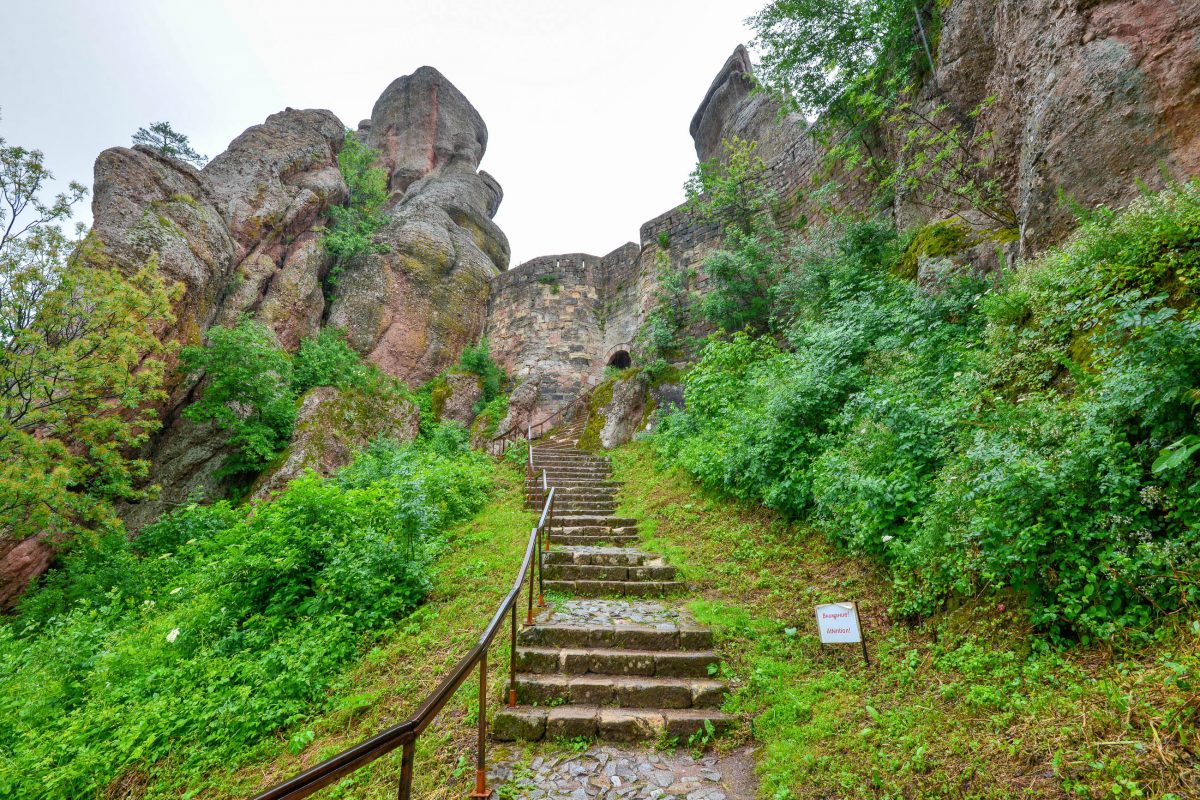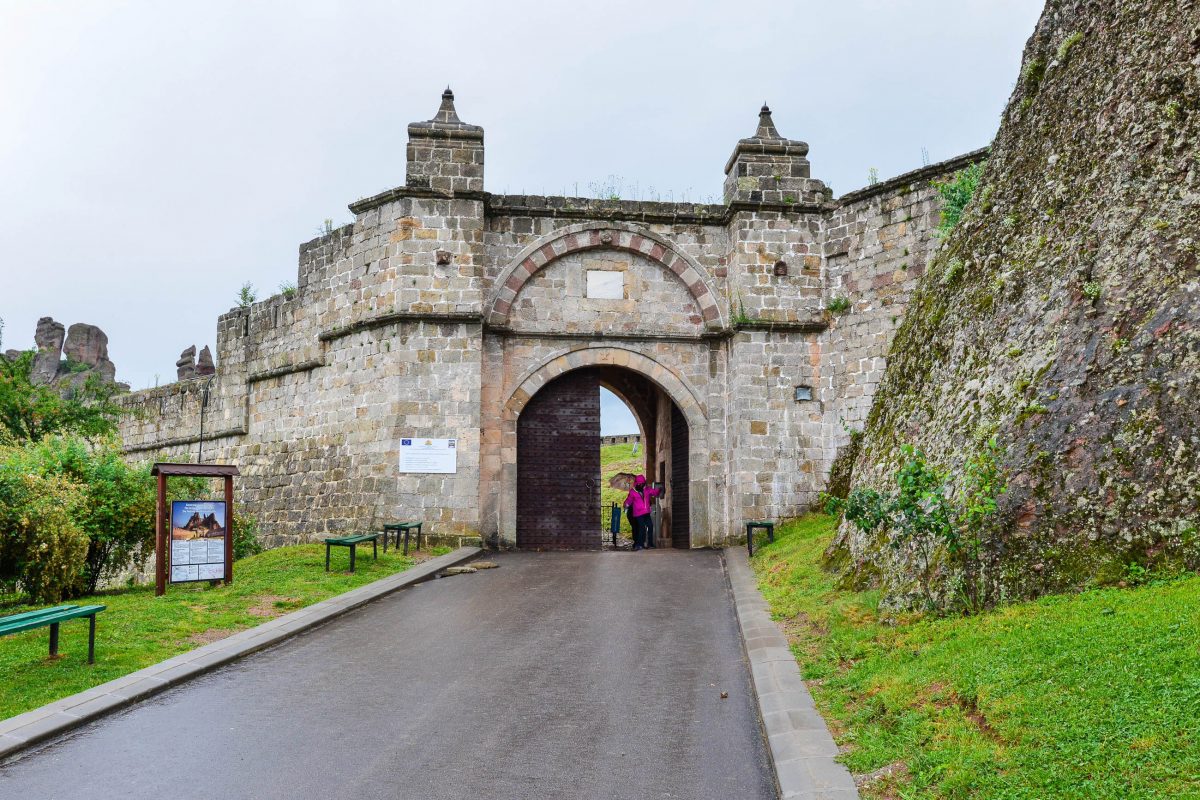Inmitten der berühmten Felsen von Belogradchik, die bereits als Neues Weltwunder nominiert waren, schmiegt sich im Nordwesten von Bulgarien die spektakuläre Kaleto-Festung in die steilen Klippen.
Die Ortschaft Belogradchik liegt ganz im Nordwesten von Bulgarien. Die touristisch kaum nennenswerte Siedlung wurde weithin bekannt, als seine spektakulären Felsen als Neues Weltwunder der Natur nominiert wurden. Die Wahl fiel 2011 letztendlich doch nicht auf die Belogradchik Rocks, was jedoch nichts an der Faszination dieses Naturwunders ändert. Dementsprechend gehören sie zu unseren Top 10 Sehenswürdigkeiten von Bulgarien.
Inhaltsverzeichnis
BILDER: Felsen und Festung von Belogradchik
Fotogalerie: Felsen und Festung von Belogradchik
Felsen von Belogradchik

Die imposanten Sandsteinformationen ziehen sich über eine Länge von rund 30 Kilometern und umgeben Belogradchik auf drei Seiten mit gewaltigen Türmen, Pfeilern und Felsnadeln. Vor über 200 Millionen Jahren wuchsen sie am Grund eines Ozeans, welcher im Zuge der Auffaltung des Balkangebirges austrocknete und so die durch Eisenoxide rosa gefärbten Steinformationen zutage treten ließ.
Die bizarren Felsen tragen heute Namen wie „Das Schloss“, „Der Reiter“, „Adam und Eva“ oder „Madonna“. Zwischen den Steintürmen sind die Überreste zahlloser Mauern und Bauten. Das am besten erhaltene Bollwerk der Belogradchik-Felsen ist die Kaleto-Festung im Südwesten der Ortschaft.
Kaleto-Festung

Beim Anblick der hoch aufragenden Felsen ist es nicht verwunderlich, dass die Römer inmitten dieser natürlich gewachsenen Wehrtürme eine Festung errichtet haben. Sie gab der Ortschaft auch ihren Namen, denn „belo grad“ bedeutet „Weiße Burg“. Die Festung entstand ab dem 1. Jahrhundert zum Schutz der Handelswege von der Donau in die römische Provinz Thracia.
Die Festung wurde von Byzantinern, Bulgaren und Türken oftmals zerstört, jedoch immer wieder aufgebaut. Ihr heutiges Erscheinungsbild erhielt die Festung 1850 unter der Herrschaft des türkischen Sultan Abdülmecit I. Noch heute umfassen ihre mit Schießscharten versehenen Festungsmauern eine Fläche von über 10.000 Quadratmetern. 35 Jahre später, im Zuge des serbisch-bulgarischen Krieges wurde die Festung das letzte Mal zu Verteidigungszwecken genutzt. 1965 wurde die Festung zum Architekturdenkmal ernannt.
Besuch der Festung von Belogradchik

Die Zufahrt zur Kaleto-Festung erfolgt über eine enge Straße, die zu zwei kostenpflichtigen Parkplätzen führt. Ein schmaler Weg und einige Treppen führen zum höchsten und schönsten Teil der Festung.
Vor dem Eingang der Festung führt ein Pfad noch weiter den Berg hinauf zu einem anderen Teil der Festung, dem so genannten „Ersten Stein“. Dieser kann durch eine etwas baufällig erscheinende Eisenstiege erklommen und ebenfalls erkundet werden. Sehenswert ist in dieser Höhe vor allem der spektakuläre Rundumblick.
Tipp: Besucher der Festung von Belogradchik sollten mit gutem Schuhwerk ausgestattet sein! Auf den sehr glatten und teilweise rutschigen Steinen besteht sonst Absturzgefahr!
Sehenswürdigkeiten in Belogradchik
Auch Belogradchik selbst hat einige interessante Ziele zu bieten. Eine Stadtbesichtigung startet am besten am zentralen Vazrazhdane-Platz gleich bei der Ortseinfahrt. Die erste Straße links führt bereits zur Kunstgalerie, in der unter den rund 200 Kunstwerken auch Gemälde von der atemberaubenden Landschaft der Umgebung zu bewundern sind.
Etwas weiter, in der Ulitsa Knyaz Boris I. ist in einem denkmalgeschützten Wohnhaus aus dem Jahr 1810 ein kleines Museum über die Stadtgeschichte zu finden.
Zu den meistbesuchten Sehenswürdigkeiten von Belogradchik gehören außerdem noch die St. Georgs-Kirche aus dem Jahr 1868, ein Observatorium des Astronomie-Instituts der Akademie der Wissenschaften mit einem der größten Teleskope Bulgariens und das Naturkundemuseum südöstlich des Ortes, mit 3.000 Exponaten das Größte im Nordwesten von Bulgarien.
Magura-Höhle
Für Höhlen-Fans lohnt sich ein Abstecher in die Magura-Höhle rund 25km vom Ort entfernt. Die 2,5km lange Schauhöhle gehört zu den größten und meistbesuchten Höhlen von Bulgarien. Der einstündige Rundgang durch die Magura-Höhle führt zu faszinierenden Felsmalereien aus Fledermausdung, die auf verschiedenste Epochen zurückgehen.
Die berühmteste Szene ist ein Sonnenmondkalender mit 366 Tagen, der im 5. Jahrtausend vor Christus geschaffen wurde. Den Abschluss des Höhlenrundgangs bildet ein herrlicher Blick auf den Rabisha-See, den größten Binnensee Bulgariens.





